820 words
4 minutes
有道翻译api
Payload: sign
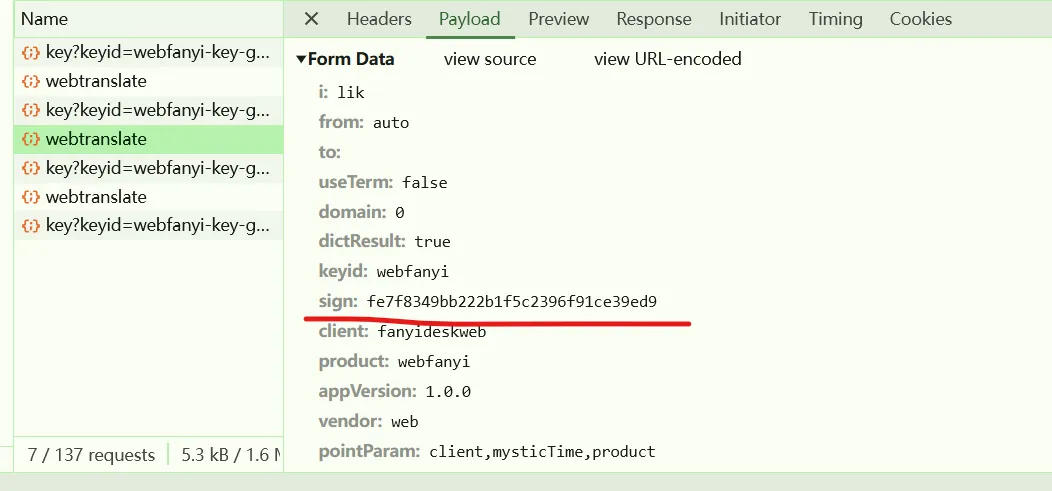
search url to locate
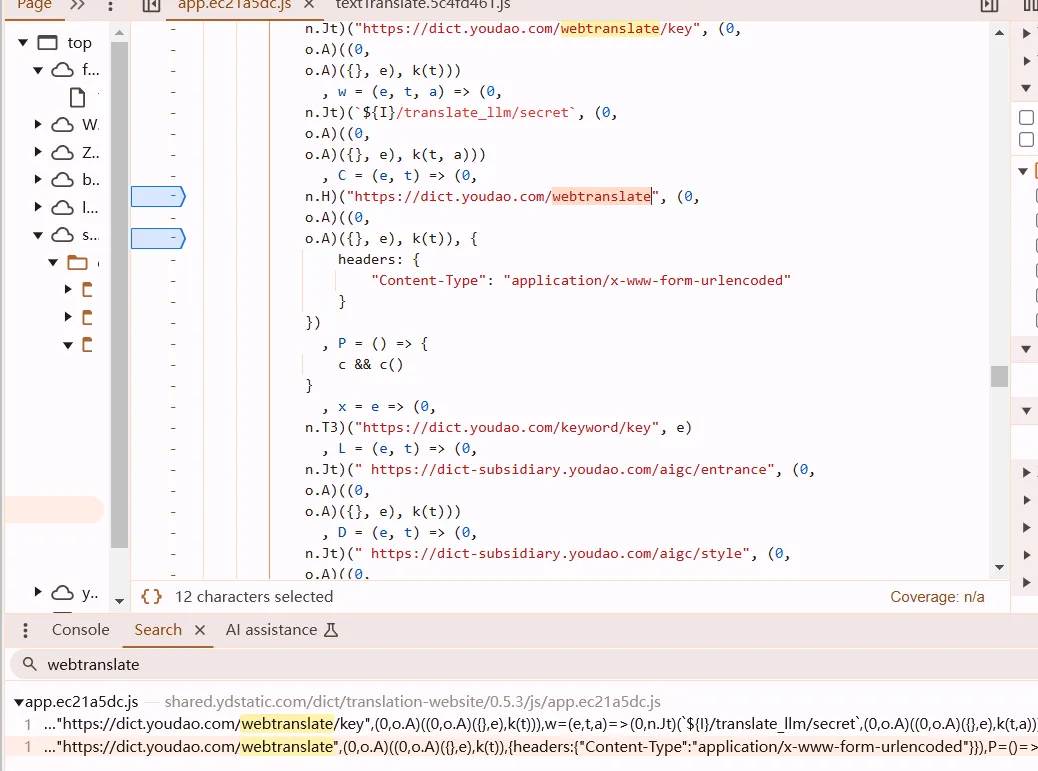
C = (e, t) => (0,
n.H)("https://dict.youdao.com/webtranslate", (0,
o.A)((0,
o.A)({}, e), k(t)), {
headers: {
"Content-Type": "application/x-www-form-urlencoded"
}
})
function C(e, t) {
return n.H("https://dict.youdao.com/webtranslate",o.A(o.A({}, e), k(t)), {
headers: {
"Content-Type": "application/x-www-form-urlencoded"
}
})
}
function C(e, t) {
const url = "https://dict.youdao.com/webtranslate";
const payload = o.A(o.A({}, e), k(t)); // merge multiple objects
const headers = {
"Content-Type": "application/x-www-form-urlencoded"
};
return n.H(url, payload, { headers });
}
assume:
e = { a: 1, b: 2 }t = "someValue"k(t)return{ c: 3, d: 4 }
then:
o.A(o.A({}, e), k(t))
First Call:
o.A({}, { a: 1, b: 2 }) // Returns { a: 1, b: 2 }Second Call:
o.A({ a: 1, b: 2 }, { c: 3, d: 4 }) // Returns { a: 1, b: 2, c: 3, d: 4 }Final result:
{ a: 1, b: 2, c: 3, d: 4 }
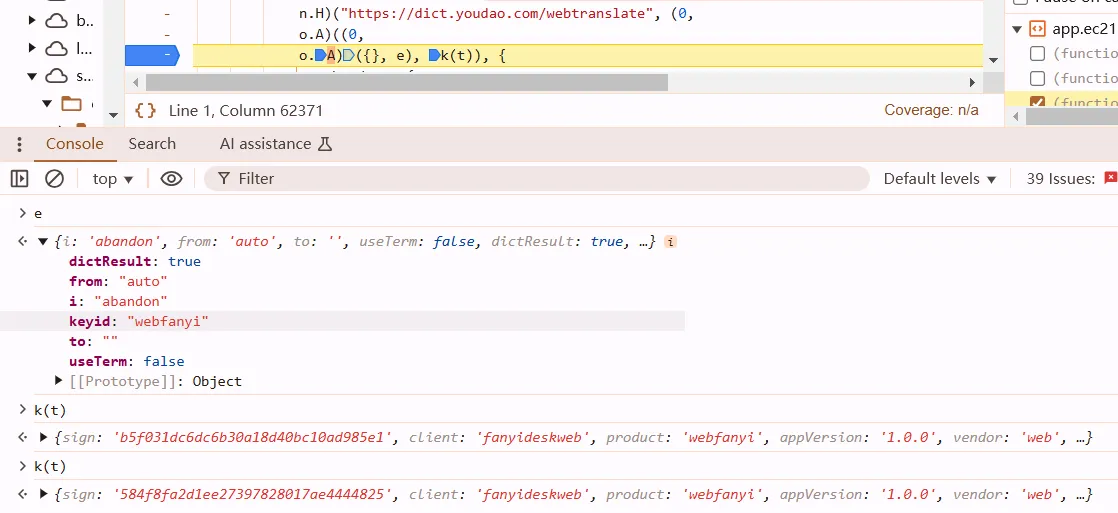
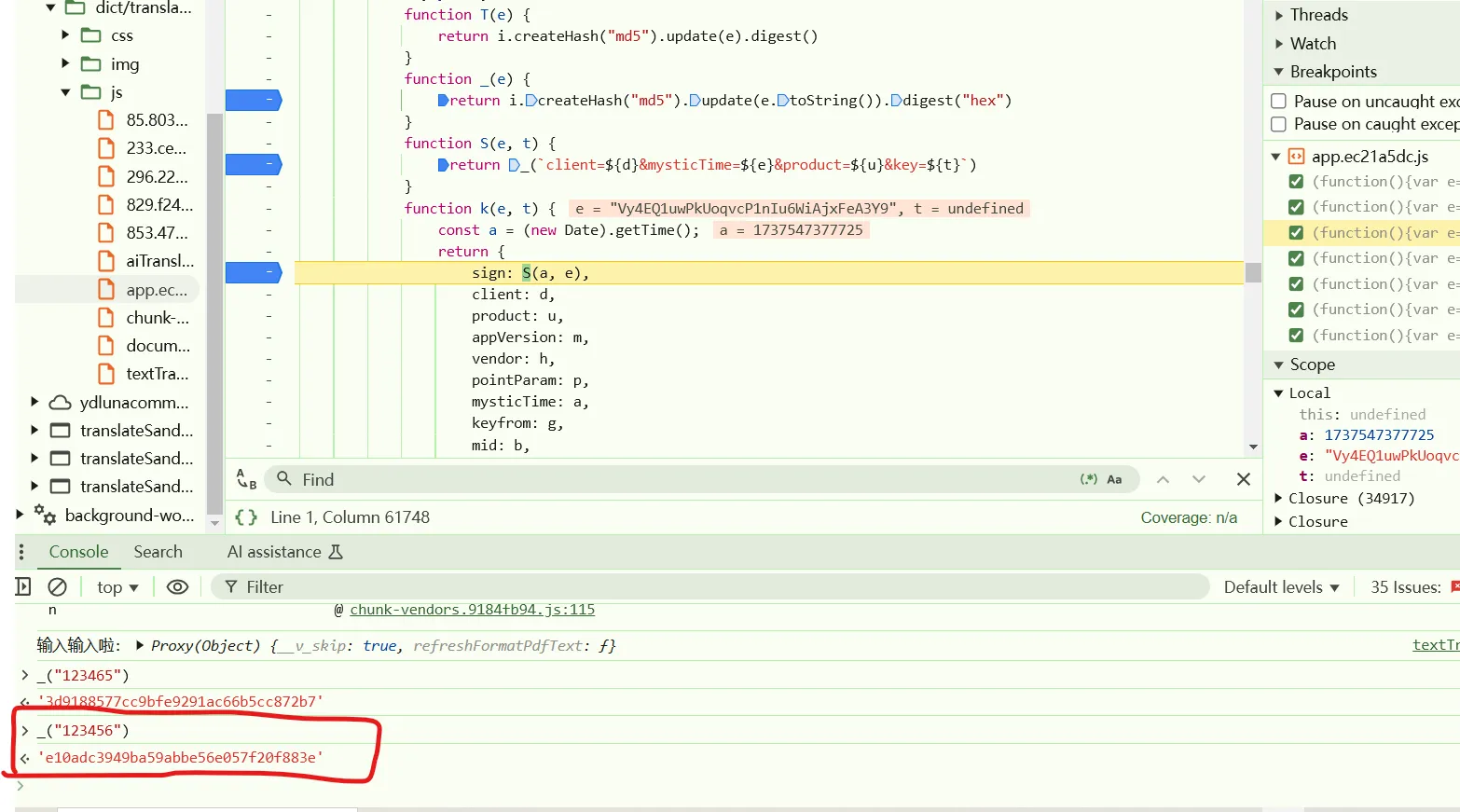
it’s the normal md5 lol. copy the return object
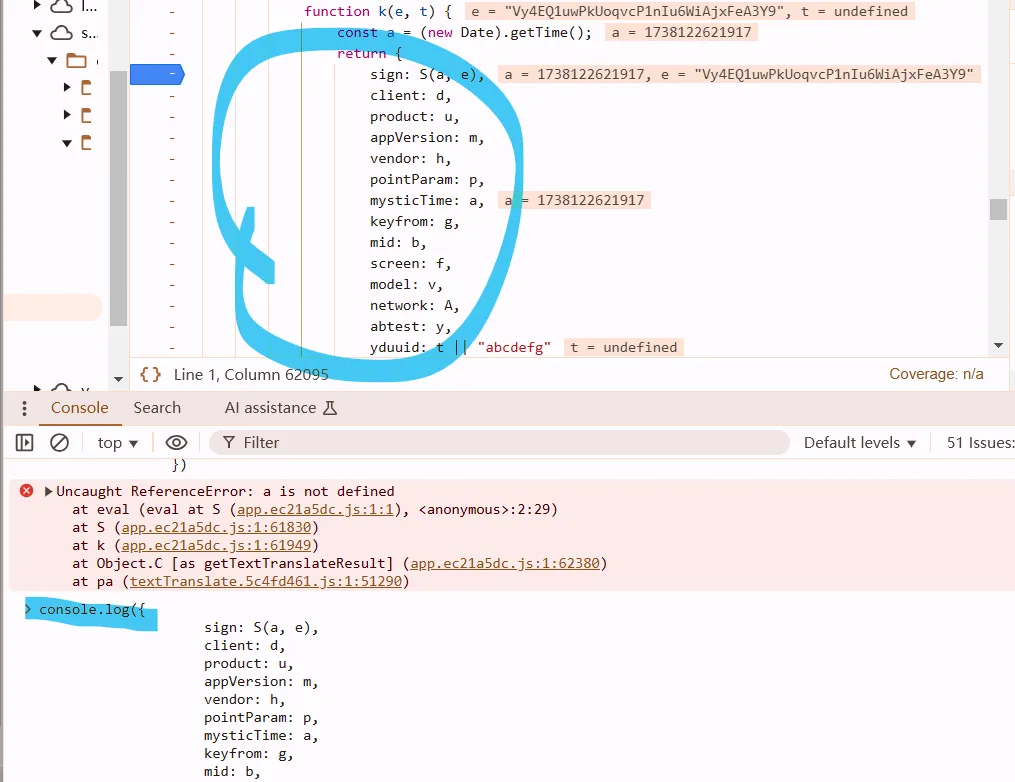
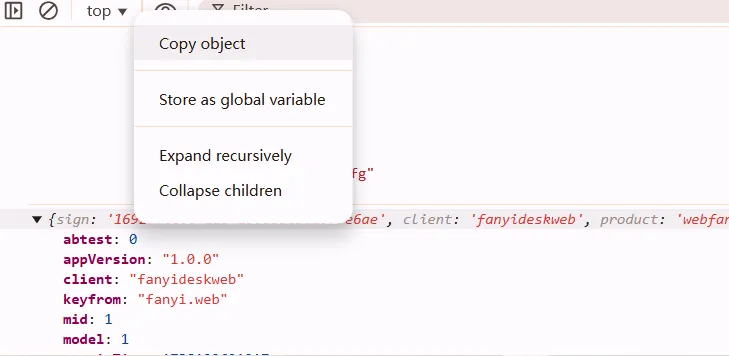
扣代码
var crypto = require("crypto");
function _(e) {
return crypto.createHash("md5").update(e.toString()).digest("hex")
}
function S(e, t) {
return _(`client=fanyideskweb&mysticTime=${e}&product=webfanyi&key=${t}`)
}
// console.log(S(e, "Vy4EQ1uwPkUoqvcP1nIu6WiAjxFeA3Y9"))
function k(word) {
var e = (new Date).getTime();
return {
"sign": S(e, "Vy4EQ1uwPkUoqvcP1nIu6WiAjxFeA3Y9"),
"client": "fanyideskweb",
"product": "webfanyi",
"appVersion": "1.0.0",
"vendor": "web",
"pointParam": "client,mysticTime,product",
"mysticTime": e,
"keyfrom": "fanyi.web",
"mid": 1,
"screen": 1,
"model": 1,
"network": "wifi",
"abtest": 0,
"yduuid": "abcdefg",
// remember to merge objects
"i": word,
"from": "auto",
"to": "",
"useTerm": false,
"domain": "0",
"dictResult": true,
"keyid": "webfanyi"
}
}
form_data = js.call("k", word)
resp = requests.post(url=url, data=form_data, headers=headers)
js2py
def S(e, t):
"""
e: int(time.time() * 1000)
t: "Vy4EQ1uwPkUoqvcP1nIu6WiAjxFeA3Y9"
"""
data_string = f'client=fanyideskweb&mysticTime={e}&product=webfanyi&key={t}'
obj = md5()
obj.update(data_string.encode("utf-8"))
return obj.hexdigest()
decrypt
content-type:application/x-www-form-urlencoded
once you find this line in headers, it indicates that its an axios.
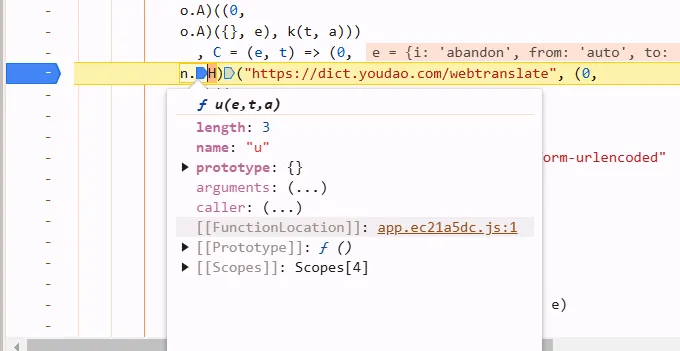
function u(e, t, a) {
return new Promise(( (o, i) => {
n.A.post(e, t, a).then((e => {
o(e.data)
}
)).catch((e => {
i(e)
}
))
}
))
}
n.A.post is a function from a library like Axios that makes an HTTP POST request.
- What is
o?ois the first parameter of thePromiseexecutor function. By convention, it is namedresolve.- It is a function provided by the
Promiseconstructor to fulfill the promise.
- What does
odo?- When
ois called, thePromisetransitions from the pending state to the fulfilled state. - The argument passed to
obecomes the resolved value of thePromise. In this case,e.datais passed too, so the resolved value of thePromisewill bee.data.
- When
- When is
ocalled?ois called inside the.then()callback, which means it is triggered when the POST request (n.A.post) succeeds.
Key Points
ois the resolve function of thePromise.- It is called when the asynchronous operation (in this case, the POST request) succeeds.
- The argument passed to
obecomes the resolved value of thePromise. - In this code,
o(e.data)resolves thePromisewith the response data from the POST request
there will be a function like u().then() to process the return value of e.data
so you need to find back, find where is then. use Call Stack.
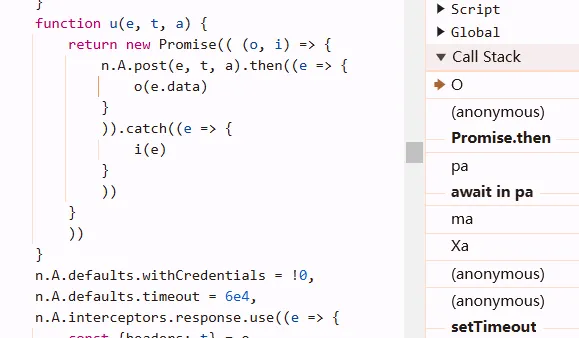


扣代码
function T(e) {
return crypto.createHash("md5").update(e).digest()
}
function O(e) {
var t = 'ydsecret://query/key/B*RGygVywfNBwpmBaZg*WT7SIOUP2T0C9WHMZN39j^DAdaZhAnxvGcCY6VYFwnHl'
var a = 'ydsecret://query/iv/C@lZe2YzHtZ2CYgaXKSVfsb7Y4QWHjITPPZ0nQp87fBeJ!Iv6v^6fvi2WN@bYpJ4'
const o = Buffer.alloc(16, T(t))
, n = Buffer.alloc(16, T(a))
, r = crypto.createDecipheriv("aes-128-cbc", o, n);
let s = r.update(e, "base64", "utf-8");
return s += r.final("utf-8"),
s
}
var e = "Z21kD9ZK1ke6ugku2ccWu-MeDWh3z252xRTQv-wZ6jcHwec8gRZUjp0VzLhd3jyUAkgcbwIDHff28GifOsWS2iT8c9s1PSMpZ1iAZMlAYvvzOqpb1Qj78CUkSI4Hf_G6_NxrSaUp3v-KPJ2TOpfUPvpaQtrUEaYYSqK_LTtCmf6Hn9roxdD36fwXw2xlIfvZ2JhJv43AyJpdIOv39bhX-WhzilJ2NTk5c2WSG0HboPfme6g3Z4Lab5Q7TNvhMBjPTtHZCdwN5W2UlZufX8cRQkjiim9dcaNuB04aR_wXCD0pQ-niP4EBwdtwYp4sa2CCynv0GykkRoBIhj6SslNo9IjVMmgx111xzedKn1Vhg53dUpTmHK8v4LCRUwOTIGdxKOuyTuYYhq62jX4S7-pFKpzO1XJ5Skqk8hz-UMP8k7oVVJ0xbpiyvl4ebFQjXLtvvT9HSMxnpfZhx-nzS-M4-ca4HjZTKEP_GbNI4jCJL7--k6zyYdH4I8NUTYryz0oPHYumyEZOQIGJzu7HHNliSfKk9Dkc-9xyn1R78Hq42YPfcu010igdl5vrSbrVY5AVXBdaFmJjStK8U836jBPqcQvY-reQL8XcsgqZhlFAxoyPeT_r1_K03geTxci9xqR2Lnwhyde9D6KrmWHs6Sy0kxEqfkDzOvqDVgqdJOPVjrbGIZGZj-zohYnSbokIlM0A2-Uu8H29Mz0qLjIHFj8IKaK6WkFVcEG4Vz835WyZiZVaXv-FB_OQNGAqzDAfDaU1drJQlYmSGvqiwKHz_YwvKw=="
console.log(O(e));
js2py
in node, definition of base64 is different with python’s. replace b64decode() with urlsafe_b64decode()
def urlsafe_b64decode(s):
"""Decode bytes using the URL- and filesystem-safe Base64 alphabet.
Argument s is a bytes-like object or ASCII string to decode. The result
is returned as a bytes object. A binascii.Error is raised if the input
is incorrectly padded. Characters that are not in the URL-safe base-64
alphabet, and are not a plus '+' or slash '/', are discarded prior to the
padding check.
The alphabet uses '-' instead of '+' and '_' instead of '/'.
"""
s = _bytes_from_decode_data(s)
s = s.translate(_urlsafe_decode_translation)
return b64decode(s)
cryptography
import hashlib
from cryptography.hazmat.primitives.ciphers import Cipher, algorithms, modes
from cryptography.hazmat.backends import default_backend
import base64
def T(e):
# Create an MD5 hash of the input string
md5 = hashlib.md5()
md5.update(e.encode('utf-8'))
return md5.digest() # Return the raw MD5 hash bytes
def O(e):
t = 'ydsecret://query/key/B*RGygVywfNBwpmBaZg*WT7SIOUP2T0C9WHMZN39j^DAdaZhAnxvGcCY6VYFwnHl'
a = 'ydsecret://query/iv/C@lZe2YzHtZ2CYgaXKSVfsb7Y4QWHjITPPZ0nQp87fBeJ!Iv6v^6fvi2WN@bYpJ4'
# Generate 16-byte keys and IVs using MD5
o = T(t)[:16] # Use the first 16 bytes of the MD5 hash as the key
n = T(a)[:16] # Use the first 16 bytes of the MD5 hash as the IV
# Decode the base64 input
ciphertext = base64.urlsafe_b64decode(e)
# Create an AES-128-CBC cipher
cipher = Cipher(algorithms.AES(o), modes.CBC(n), backend=default_backend())
decryptor = cipher.decryptor()
# Decrypt the data
decrypted_data = decryptor.update(ciphertext) + decryptor.finalize()
# Remove padding (if any) and decode to UTF-8
return decrypted_data.decode('utf-8').rstrip('\x00')
print(O(e))
Crypto
from Crypto.Cipher import AES
from Crypto.Util.Padding import unpad
import base64
import hashlib
def T(s):
return hashlib.md5(s.encode('utf-8')).digest() # Compute MD5 hash and return bytes
t = 'ydsecret://query/key/B*RGygVywfNBwpmBaZg*WT7SIOUP2T0C9WHMZN39j^DAdaZhAnxvGcCY6VYFwnHl'
a = 'ydsecret://query/iv/C@lZe2YzHtZ2CYgaXKSVfsb7Y4QWHjITPPZ0nQp87fBeJ!Iv6v^6fvi2WN@bYpJ4'
decoded_data = base64.urlsafe_b64decode(e)
key = T(t) # AES-128 requires a 16-byte key
iv = T(a) # IV should also be 16 bytes
aes = AES.new(key=key, mode=AES.MODE_CBC, iv=iv)
decrypted_data = unpad(aes.decrypt(decoded_data), AES.block_size)
# Convert decrypted bytes to string
result = decrypted_data.decode('utf-8')
print(result)
